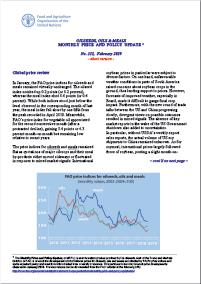
Oilseeds, Oils and Meals. Monthly Price and Policy Update No.115, February 2019
13/09/2019
In January, the FAO price indices for oilseeds and meals remained virtually unchanged. The oilseed index notched up 0.2 points (or 0.2 percent), whereas the meal index shed 0.6 points (or 0.4 percent). While both indices stood just below the level observed in the corresponding month of last year, the meal index fell short by one fifth from the peak recorded in April 2018. Meanwhile, FAO’s price index for vegetable oil appreciated for the second consecutive month (after a protracted decline), gaining 5.4 points or 4.3 percent month-on-month but remaining low relative to recent years.
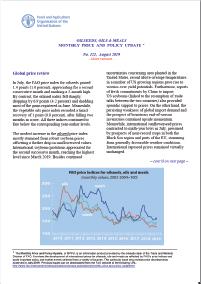
Oilseeds, Oils and Meals. Monthly Price and Policy Update No.121, August 2019
13/09/2019
In July, the FAO price index for oilseeds gained 1.4 points (1.0 percent), appreciating for a second consecutive month and marking a 5-month high. By contrast, the oilmeal index fell sharply, dropping by 6.9 points (4.2 percent) and shedding most of the gains registered in June. Meanwhile, the vegetable oils price index recorded a timid recovery of 1 point (0.8 percent), after falling two months in a row. All three indices continued to fare below the corresponding year-earlier levels.
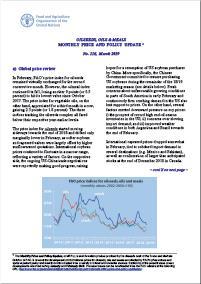
Oilseeds, Oils and Meals. Monthly Price and Policy Update No.116, March 2019
13/09/2019
In February, FAO’s price index for oilseeds remained virtually unchanged for the second consecutive month. However, the oilmeal index continued its fall, losing another 9 points (or 5.5 percent) to hit its lowest value since October 2017. The price index for vegetable oils, on the other hand, appreciated for a third month in a row, gaining 2.3 points (or 1.8 percent). The three indices tracking the oilseeds complex all fared below their respective year-earlier levels.
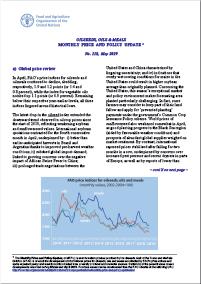
Oilseeds, Oils and Meals. Monthly Price and Policy Update No.118, May 2019
13/09/2019
In April, FAO’s price indices for oilseeds and oilmeals continued to decline, shedding, respectively, 1.9 and 1.2 points (or 1.4 and 0.8 percent), while the index for vegetable oils notched up 1.1 points (or 0.9 percent). Remaining below their respective year-earlier levels, all three indices lingered around historical lows.
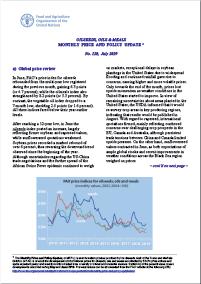
Oilseeds, Oils and Meals. Monthly Price and Policy Update No.120, July 2019
13/09/2019
In June, FAO’s price index for oilseeds rebounded from the multi-year low registered during the previous month, gaining 6.3 points (or 4.7 percent), while the oilmeals index also strengthened by 8.2 points (or 5.3 percent). By contrast, the vegetable oil index dropped to a 7-month low, shedding 2.0 points (or 1.6 percent). All three indices fared below their year-earlier levels.
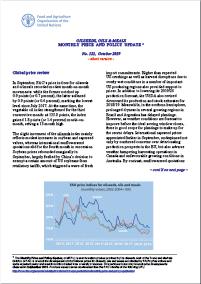
Oilseeds, Oils and Meals. Monthly Price and Policy Update No.123, October 2019
13/09/2019
In September, FAO’s price indices for oilseeds and oilmeals recorded modest month-on-month movements: while the former notched up 0.9 points (or 0.7 percent), the latter softened by 0.9 points (or 0.6 percent), marking the lowest level since July 2017. At the same time, the vegetable oil index strengthened for the third consecutive month: at 135.8 points, the index gained 1.8 points (or 1.4 percent) month-on- month, setting a 13-month high.
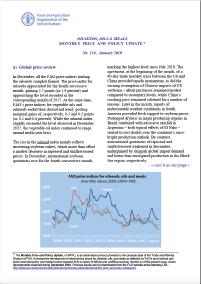
Oilseeds, Oils and Meals. Monthly Price and Policy Update No.114, January 2019
13/09/2019
In December, all the FAO price indices trailing the oilseeds complex firmed. The price index for oilseeds appreciated for the fourth successive month, gaining 2.7 points (or 1.9 percent) and approaching the level recorded in the corresponding month of 2017. At the same time, FAO’s price indices for vegetable oils and oilmeals ended their downward trend, posting marginal gains of, respectively, 0.3 and 0.5 points (or 0.2 and 0.4 percent). While the oilmeal index slightly exceeded the level observed in December 2017, the vegetable oil index continued to range around multi-year lows.
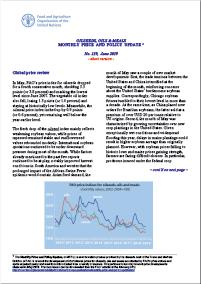
Oilseeds, Oils and Meals. Monthly Price and Policy Update No.119, June 2019
13/09/2019
In May, FAO’s price index for oilseeds dropped for a fourth consecutive month, shedding 5.3 points (or 3.8 percent) and marking the lowest level since June 2007. The vegetable oil index also fell, losing 1.3 points (or 1.0 percent) and staying at historically low levels. Meanwhile, the oilmeal price index inched up by 0.9 points (or 0.6 percent), yet remaining well below the year-earlier level.
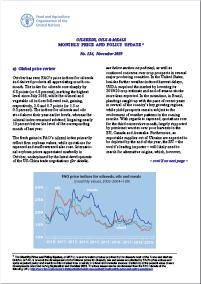
Oilseeds, Oils and Meals. Monthly Price and Policy Update No.124, November 2019
13/09/2019
October has seen FAO’s price indices for oilseeds and derived products all appreciating month-on- month. The index for oilseeds rose sharply by 6.8 points (or 4.8 percent), marking the highest level since July 2018, while the oilmeal and vegetable oil indices followed suit, gaining, respectively, 2.0 and 0.7 points (or 1.3 or 0.5 percent). The indices for oilseeds and oils stood above their year-earlier levels, whereas the oilmeal index remained subdued, lingering nearly 10 percent below the level of the corresponding month of last year.
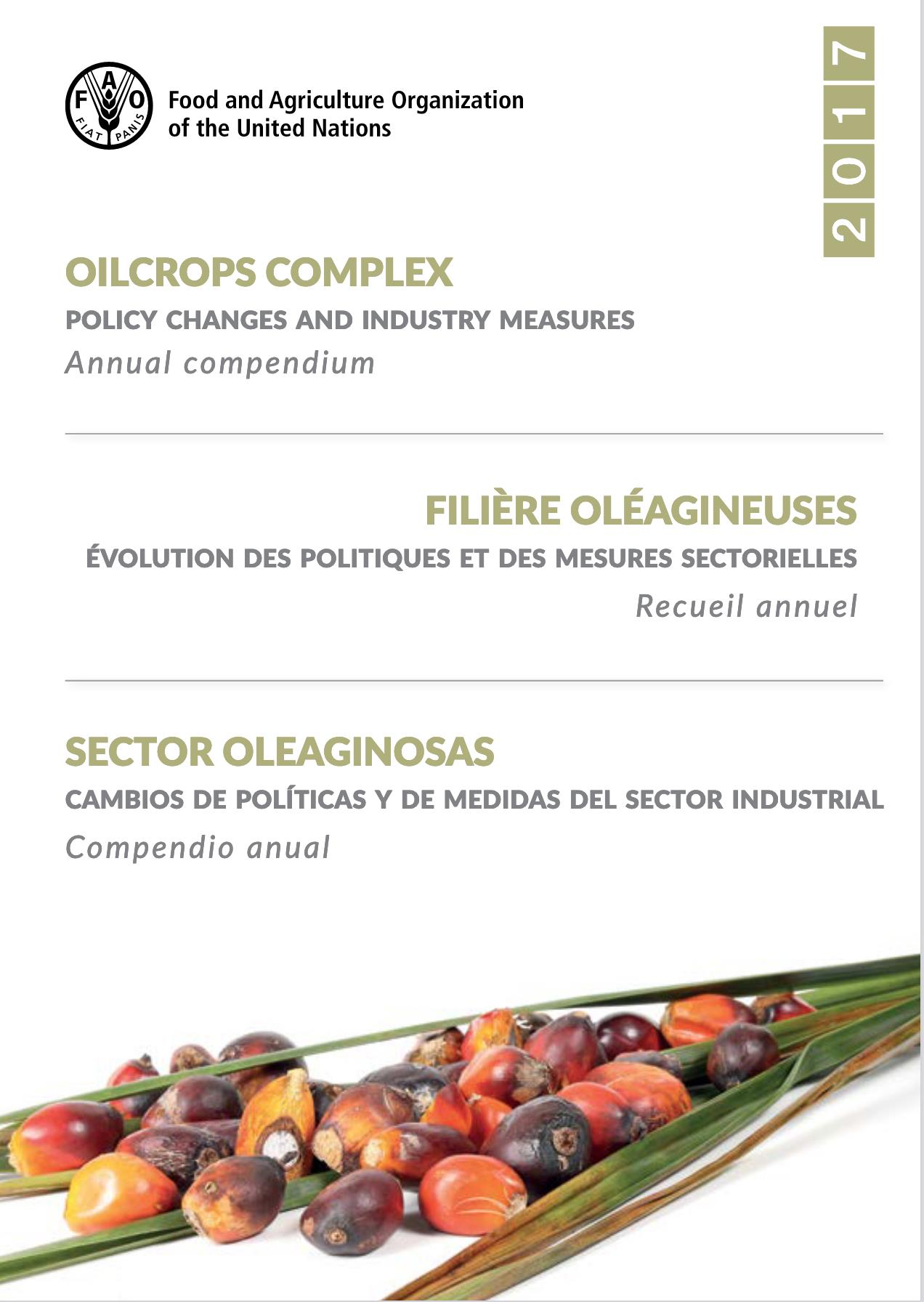
Oilcrops complex: policy changes and industry measures - Annual compendium - 2017
25/12/2018
The 2017 compendium offers an overview of salient government policies and related private sector measures concerning global and national markets for oilcrops and derived products. Its purpose is to facilitate the work of policy makers, market experts, analysts and other interested stakeholders by providing a short, concise overview of policy developments relevant to the sector. Detailed news items are presented in tabular form (in English only), preceeded by a brief discussion of the key policy trends observed in the year under review.
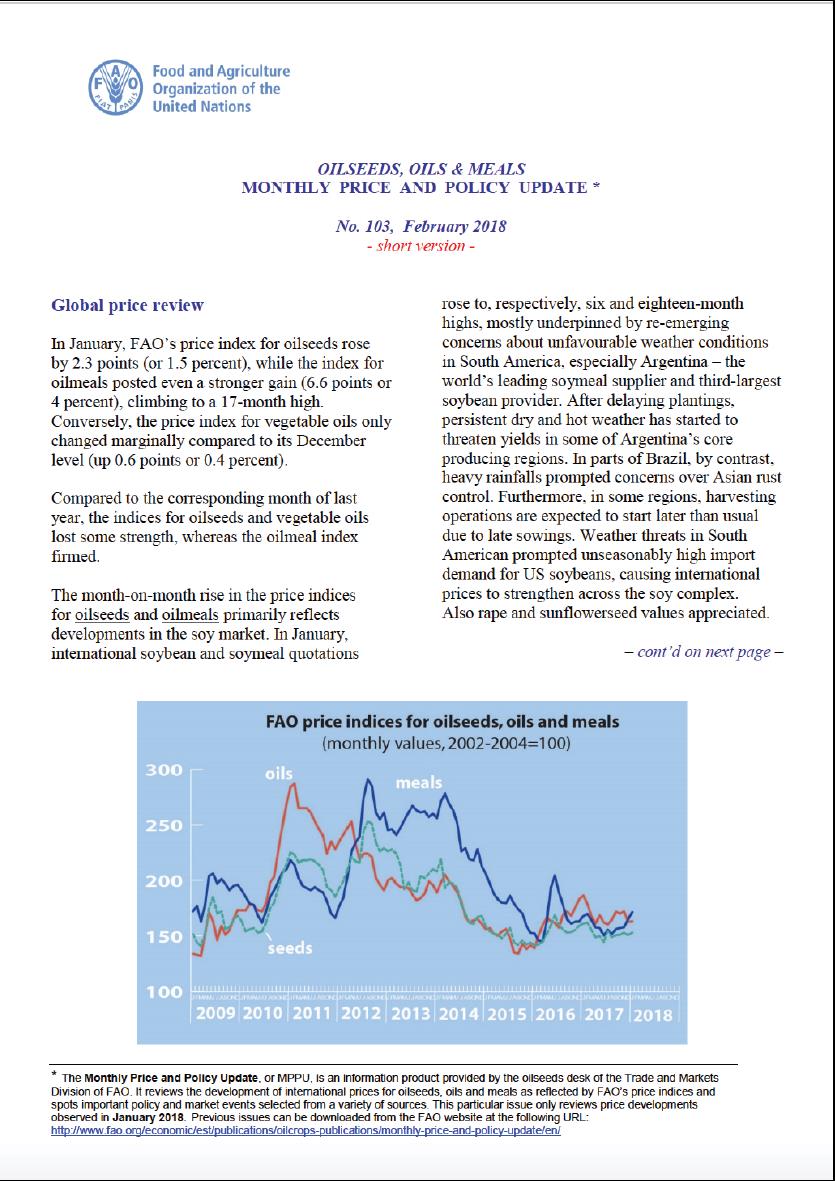
Oilseeds, Oils and Meals. Monthly Price and Policy Update No.103, February 2018
13/09/2018
In January, FAO’s price index for oilseeds rose by 2.3 points (or 1.5 percent), while the index for oilmeals posted even a stronger gain (6.6 points or 4 percent), climbing to a 17-month high. Conversely, the price index for vegetable oils only changed marginally compared to its December level (up 0.6 points or 0.4 percent).
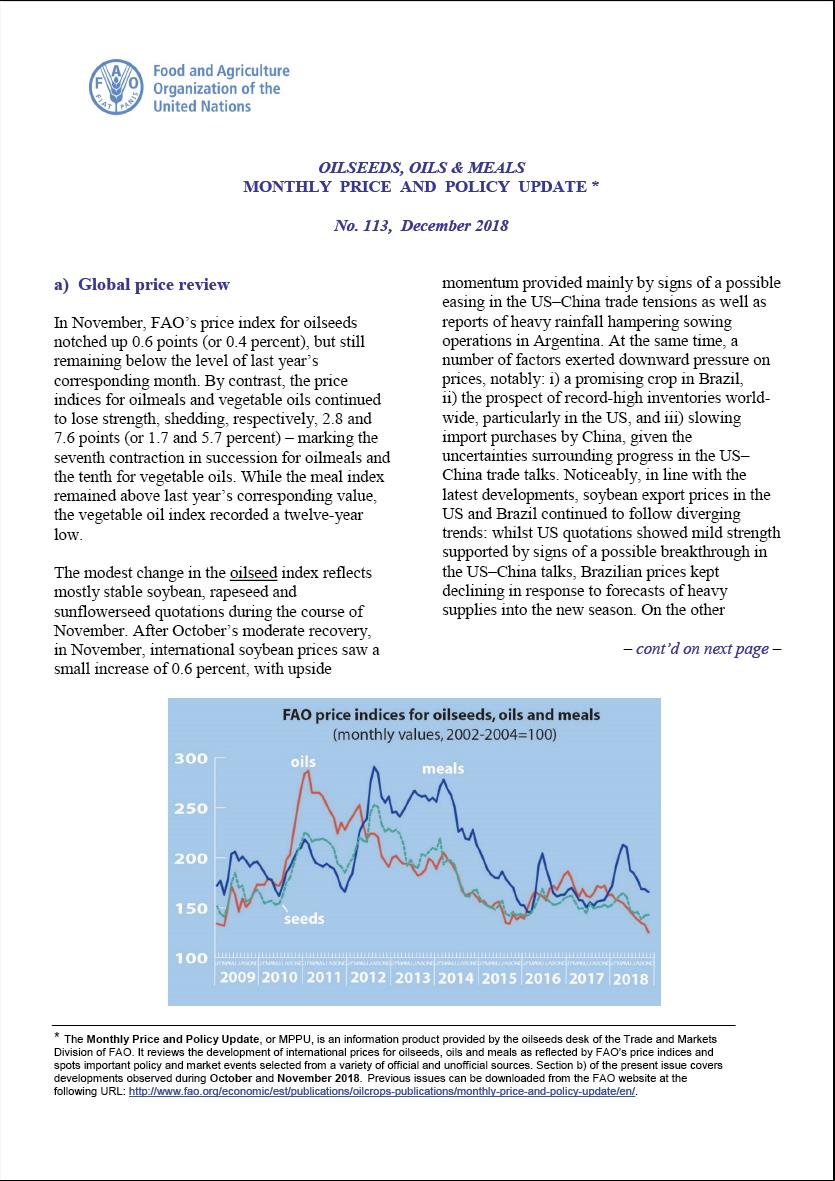
Oilseeds, Oils and Meals. Monthly Price and Policy Update No.113, December 2018
13/09/2018
In November, FAO’s price index for oilseeds notched up 0.6 points (or 0.4 percent), but still remaining below the level of last year’s corresponding month. By contrast, the price indices for oilmeals and vegetable oils continued to lose strength, shedding, respectively, 2.8 and 7.6 points (or 1.7 and 5.7 percent) – marking the seventh contraction in succession for oilmeals and the tenth for vegetable oils. While the meal index remained above last year’s corresponding value, the vegetable oil index recorded a twelve-year low.
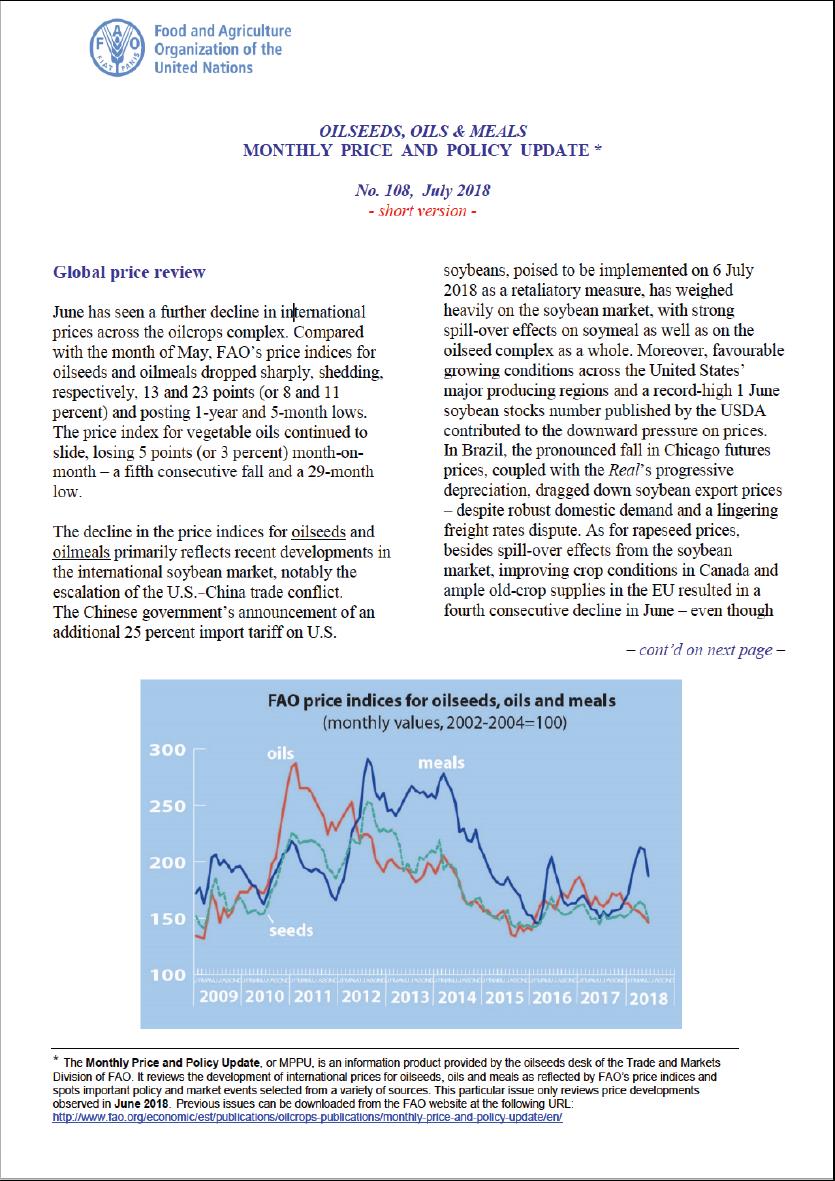
Oilseeds, Oils and Meals. Monthly Price and Policy Update No.108, July 2018
13/09/2018
June has seen a further decline in international prices across the oilcrops complex. Compared with the month of May, FAO’s price indices for oilseeds and oilmeals dropped sharply, shedding, respectively, 13 and 23 points (or 8 and 11 percent) and posting 1-year and 5-month lows. The price index for vegetable oils continued to slide, losing 5 points (or 3 percent) month-on- month – a fifth consecutive fall and a 29-month low.
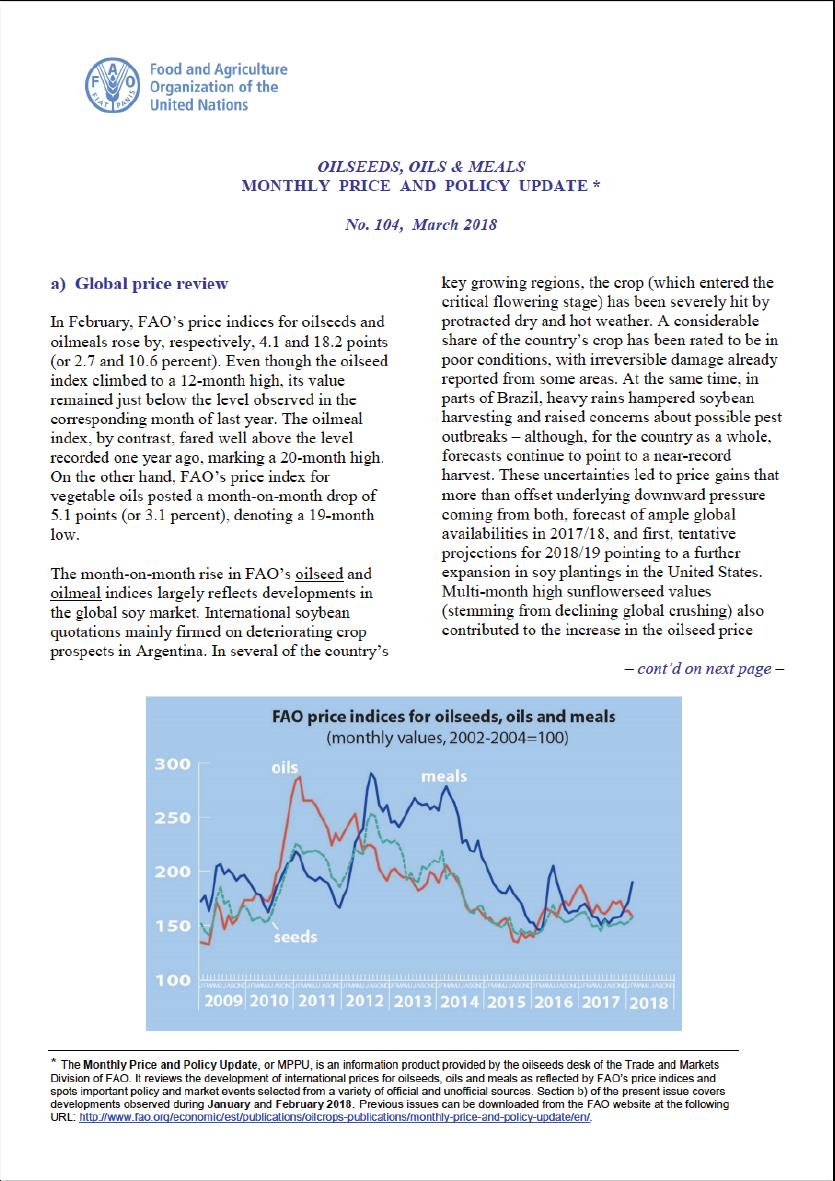
Oilseeds, Oils and Meals. Monthly Price and Policy Update No.104, March 2018
13/09/2018
In February, FAO’s price indices for oilseeds and oilmeals rose by, respectively, 4.1 and 18.2 points (or 2.7 and 10.6 percent). Even though the oilseed index climbed to a 12-month high, its value remained just below the level observed in the corresponding month of last year. The oilmeal index, by contrast, fared well above the level recorded one year ago, marking a 20-month high. On the other hand, FAO’s price index for vegetable oils posted a month-on-month drop of 5.1 points (or 3.1 percent), denoting a 19-month low.
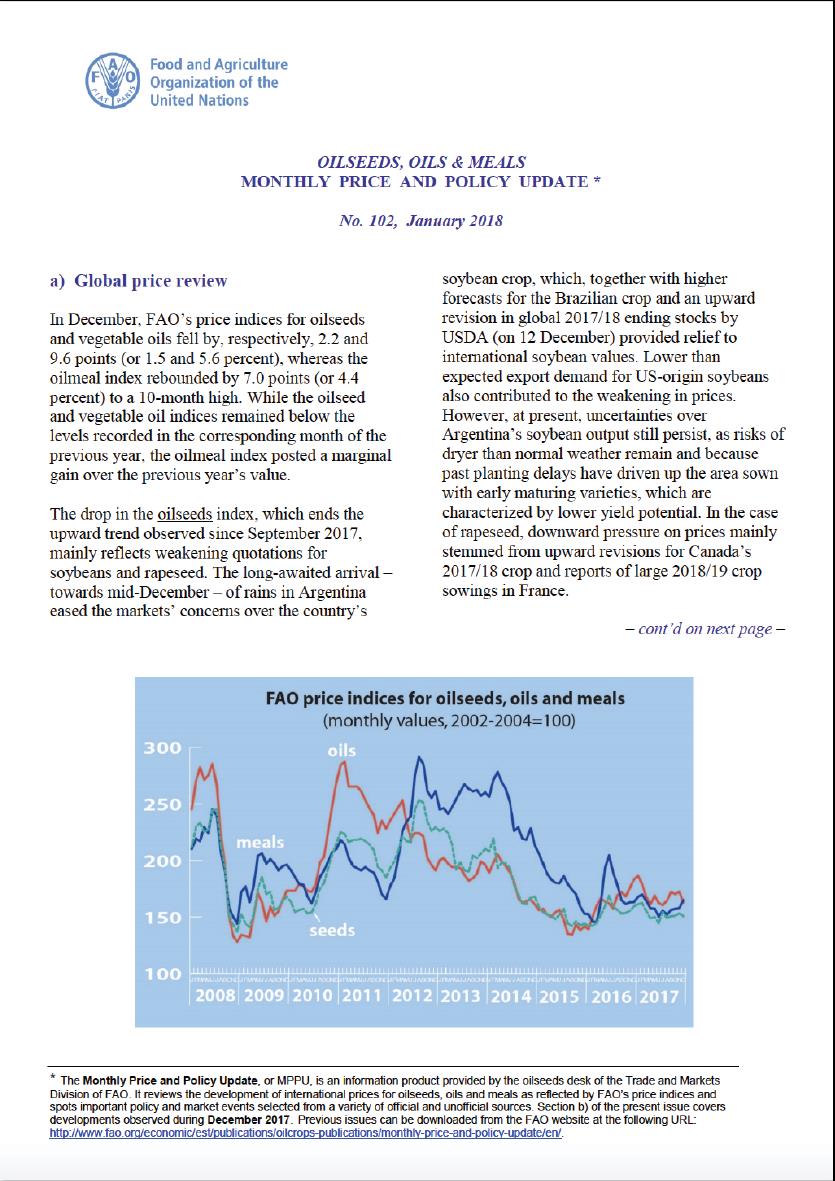
Oilseeds, Oils and Meals. Monthly Price and Policy Update No.102, January 2018
13/09/2018
In December, FAO’s price indices for oilseeds and vegetable oils fell by, respectively, 2.2 and 9.6 points (or 1.5 and 5.6 percent), whereas the oilmeal index rebounded by 7.0 points (or 4.4 percent) to a 10-month high. While the oilseed and vegetable oil indices remained below the levels recorded in the corresponding month of the previous year, the oilmeal index posted a marginal gain over the previous year’s value.
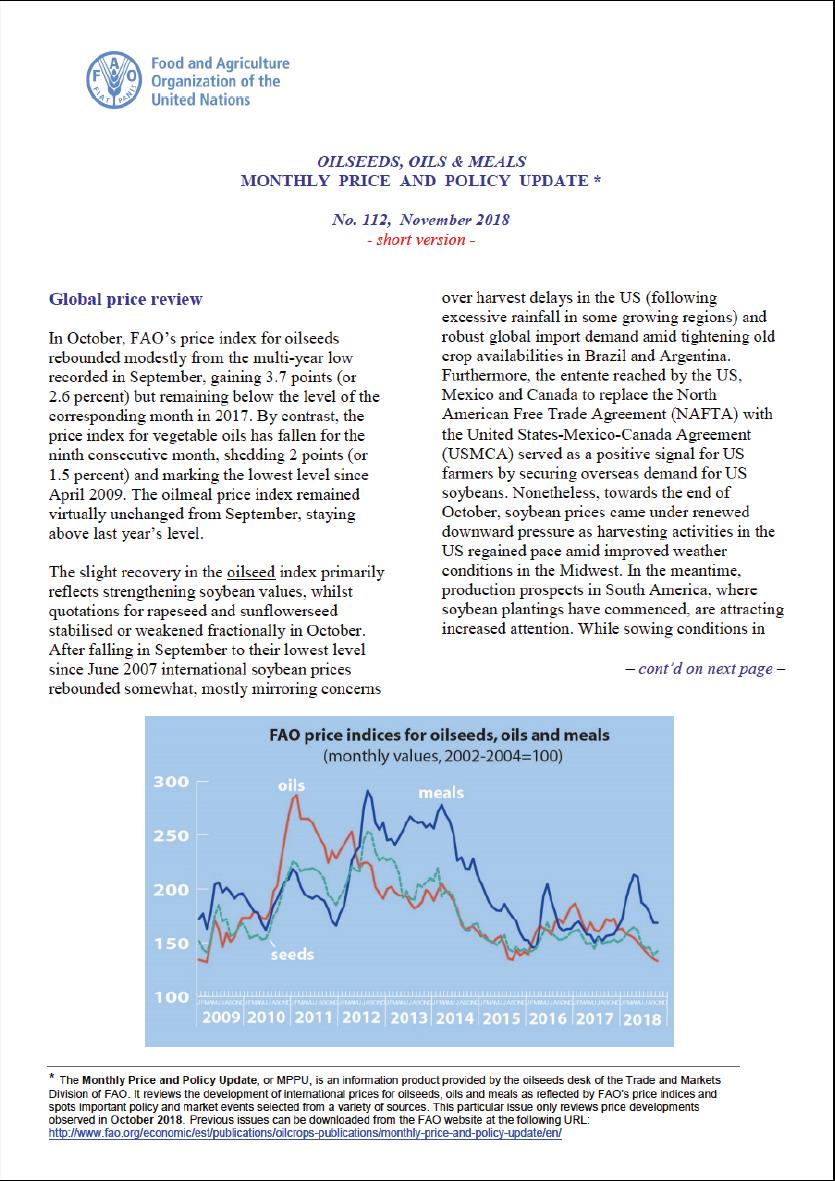
Oilseeds, Oils and Meals. Monthly Price and Policy Update No.112, November 2018
13/09/2018
In October, FAO’s price index for oilseeds rebounded modestly from the multi-year low recorded in September, gaining 3.7 points (or 2.6 percent) but remaining below the level of the corresponding month in 2017. By contrast, the price index for vegetable oils has fallen for the ninth consecutive month, shedding 2 points (or 1.5 percent) and marking the lowest level since April 2009. The oilmeal price index remained virtually unchanged from September, staying above last year’s level.
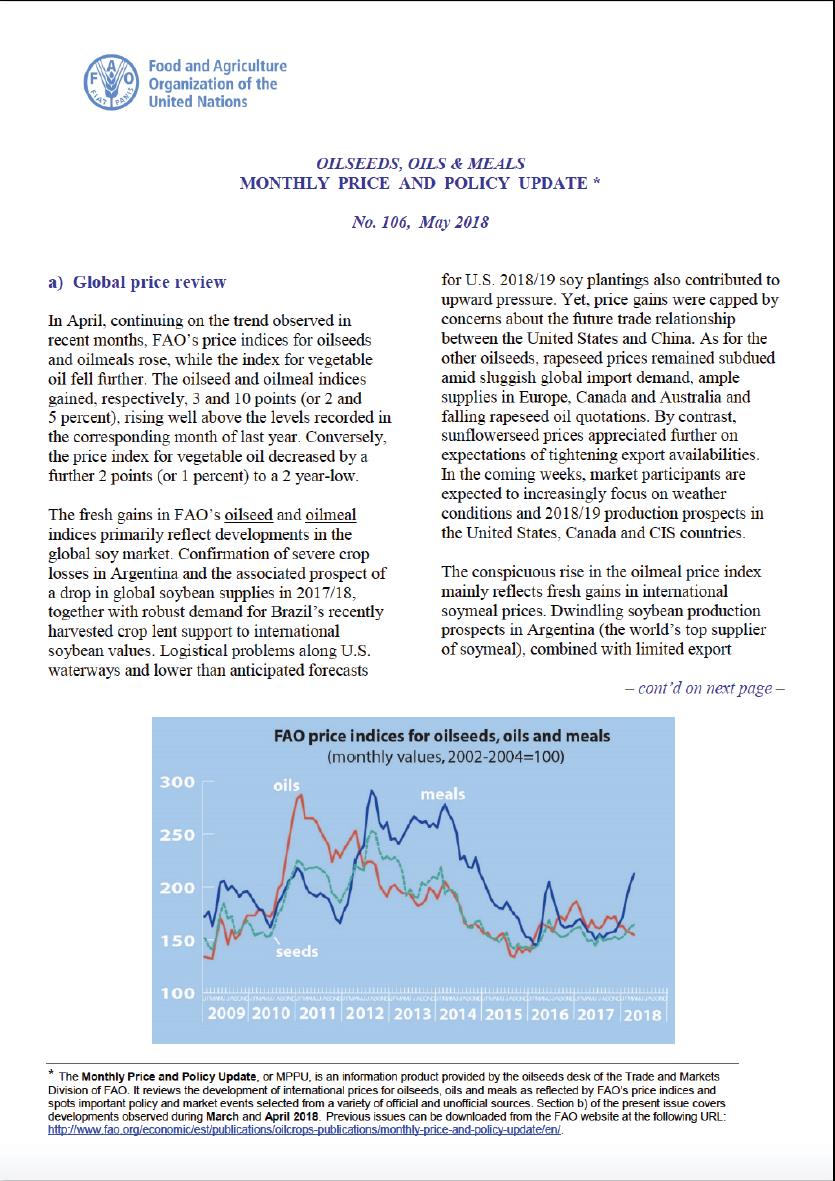
Oilseeds, Oils and Meals. Monthly Price and Policy Update No.106, May 2018
13/09/2018
In April, continuing on the trend observed in recent months, FAO’s price indices for oilseeds and oilmeals rose, while the index for vegetable oil fell further. The oilseed and oilmeal indices gained, respectively, 3 and 10 points (or 2 and 5 percent), rising well above the levels recorded in the corresponding month of last year. Conversely, the price index for vegetable oil decreased by a further 2 points (or 1 percent) to a 2 year-low.
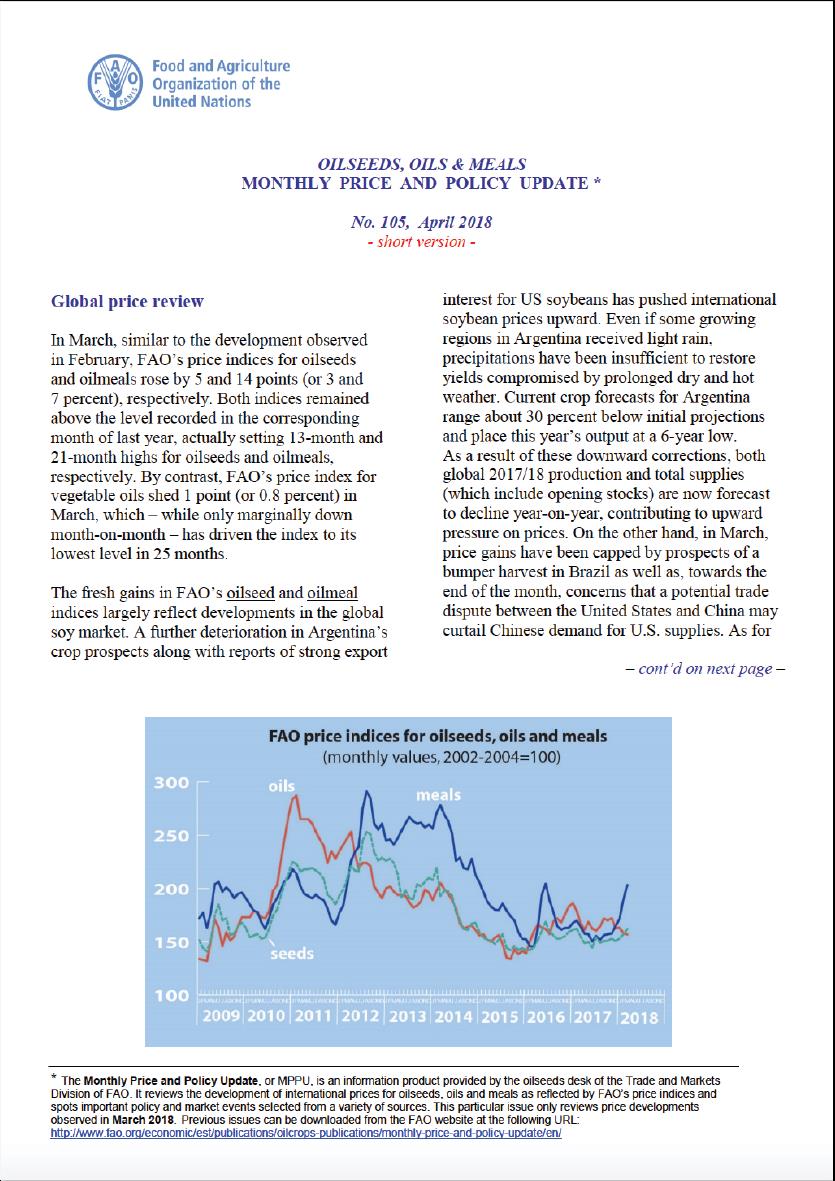
Oilseeds, Oils and Meals. Monthly Price and Policy Update No.105, April 2018
13/09/2018
In March, similar to the development observed in February, FAO’s price indices for oilseeds and oilmeals rose by 5 and 14 points (or 3 and 7 percent), respectively. Both indices remained above the level recorded in the corresponding month of last year, actually setting 13-month and 21-month highs for oilseeds and oilmeals, respectively. By contrast, FAO’s price index for vegetable oils shed 1 point (or 0.8 percent) in March, which – while only marginally down month-on-month – has driven the index to its lowest level in 25 months.
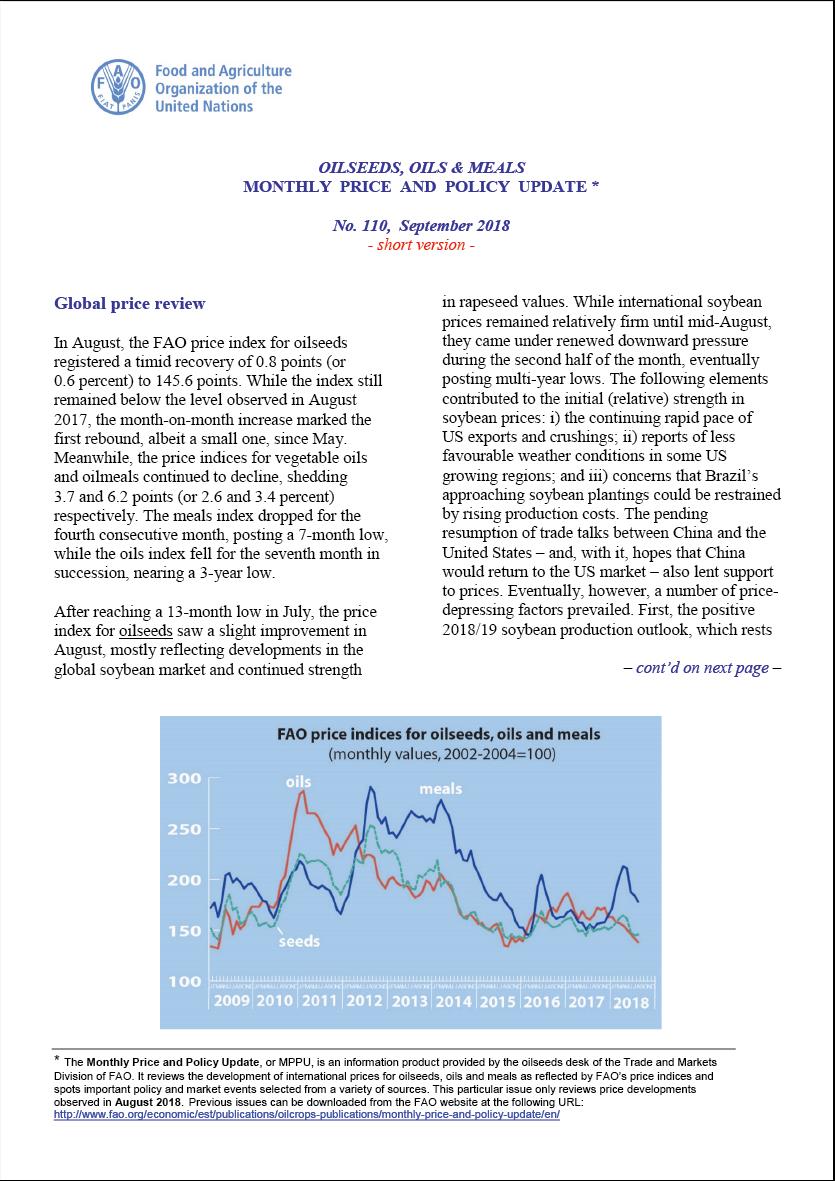
Oilseeds, Oils and Meals. Monthly Price and Policy Update No.110, September 2018
13/09/2018
In August, the FAO price index for oilseeds registered a timid recovery of 0.8 points (or 0.6 percent) to 145.6 points. While the index still remained below the level observed in August 2017, the month-on-month increase marked the first rebound, albeit a small one, since May. Meanwhile, the price indices for vegetable oils and oilmeals continued to decline, shedding 3.7 and 6.2 points (or 2.6 and 3.4 percent) respectively. The meals index dropped for the fourth consecutive month, posting a 7-month low, while the oils index fell for the seventh month in succession, nearing a 3-year low.
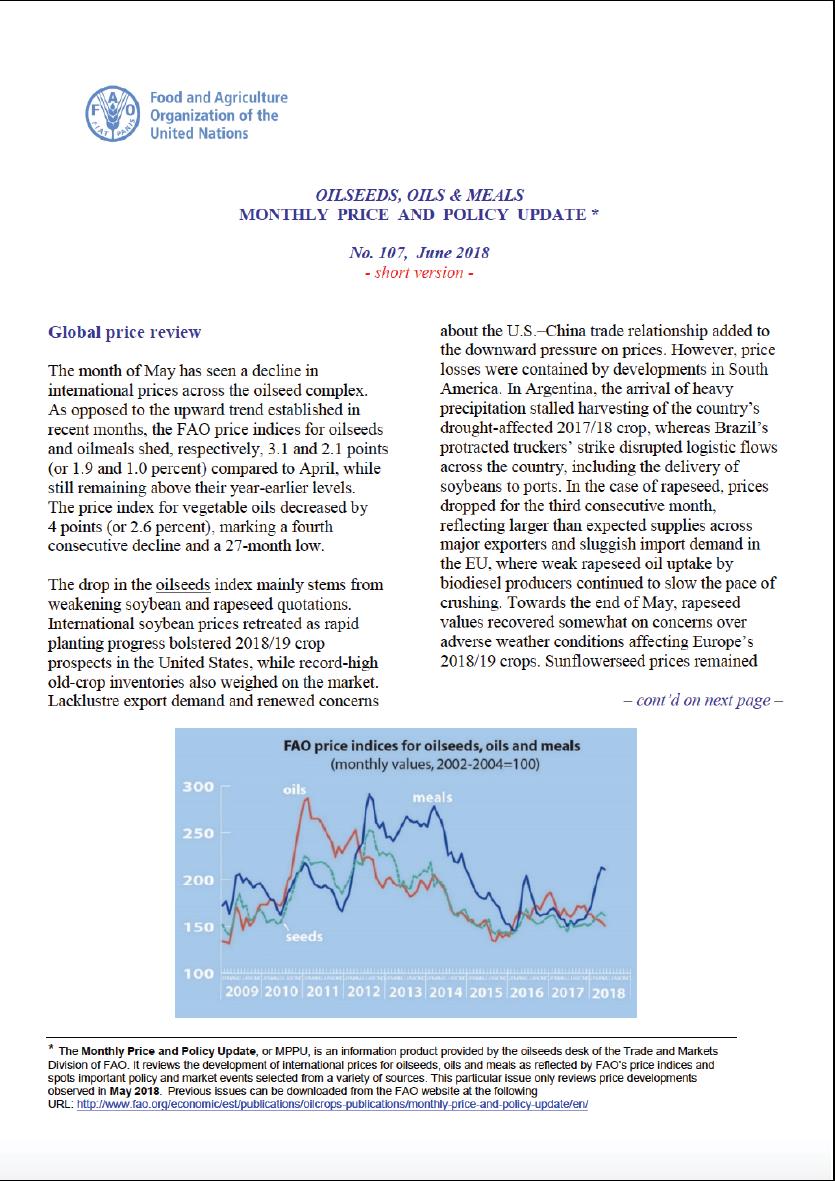
Oilseeds, Oils and Meals. Monthly Price and Policy Update No.107, June 2018
13/09/2018
The month of May has seen a decline in international prices across the oilseed complex. As opposed to the upward trend established in recent months, the FAO price indices for oilseeds and oilmeals shed, respectively, 3.1 and 2.1 points (or 1.9 and 1.0 percent) compared to April, while still remaining above their year-earlier levels. The price index for vegetable oils decreased by 4 points (or 2.6 percent), marking a fourth consecutive decline and a 27-month low.
